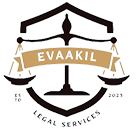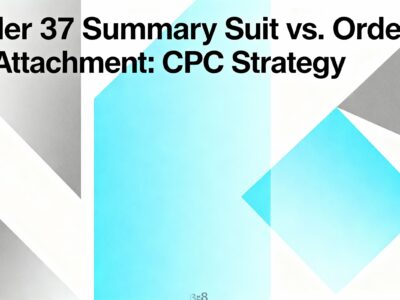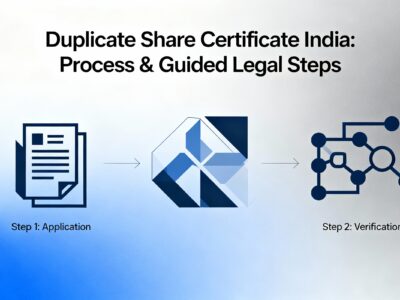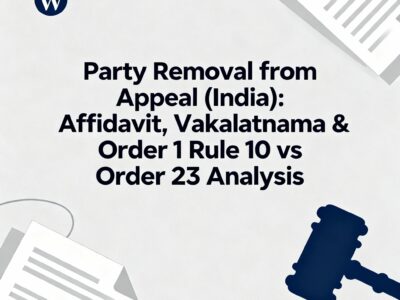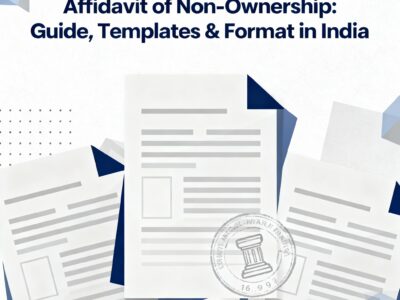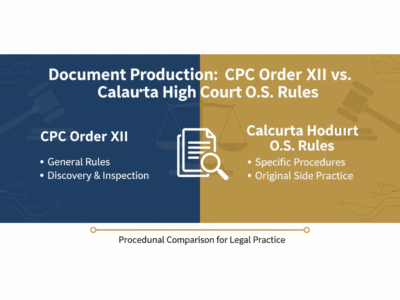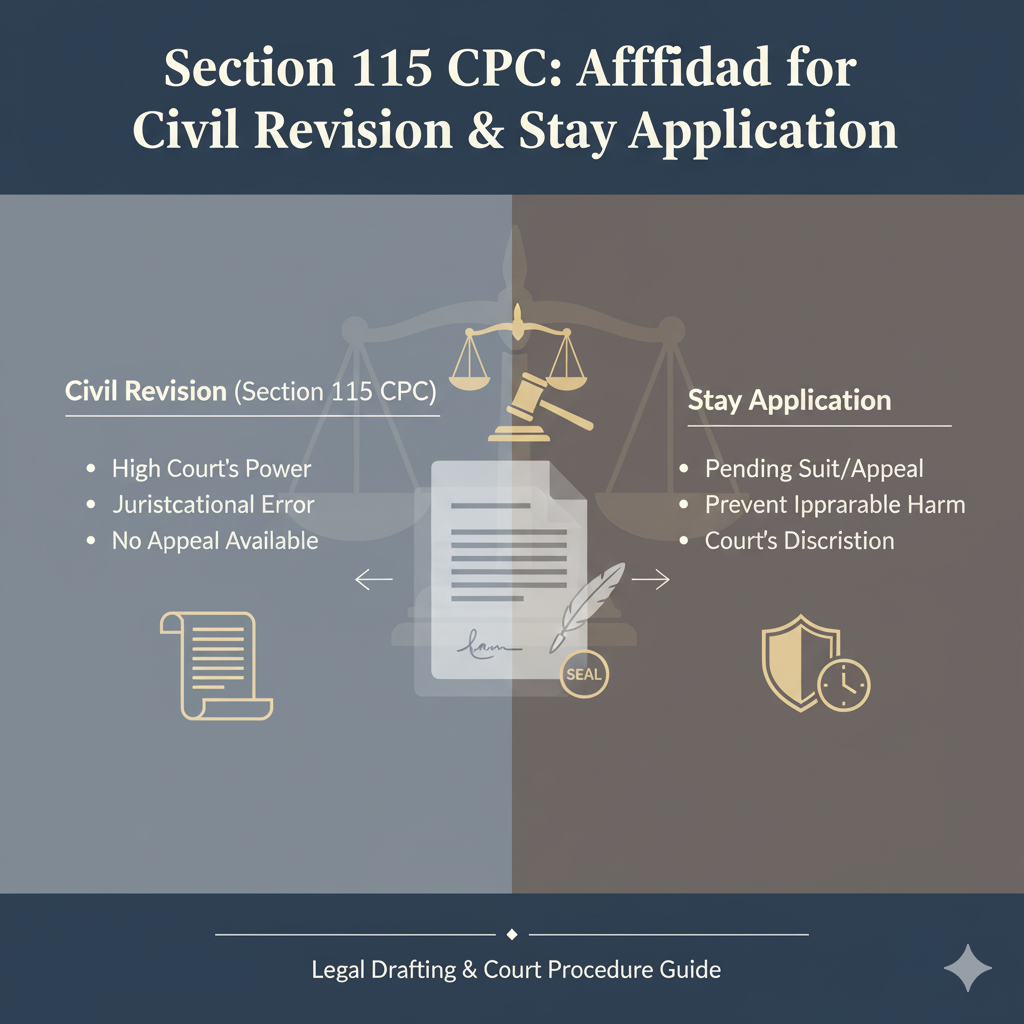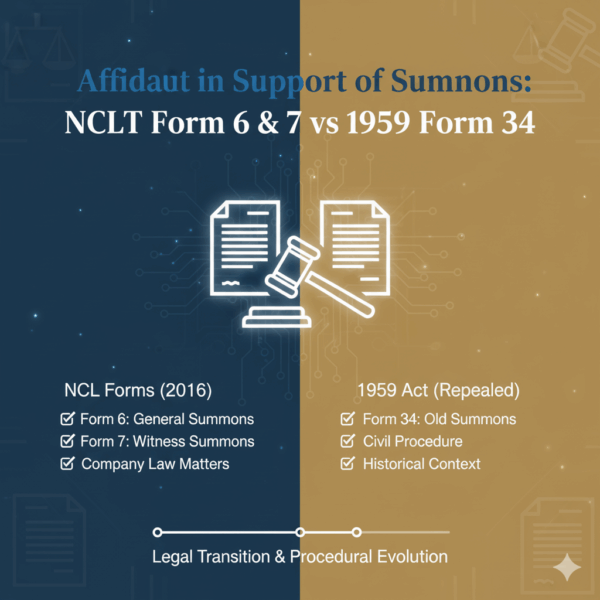Filing a Scheme of Compromise or Arrangement (C&A) under Section 230 of the Companies Act, 2013, requires a critical first step: the “First Motion” application. Before a company can ask shareholders to vote, it must seek permission from the National Company Law Tribunal (NCLT) to convene the meetings.
This application (Form NCLT-1) hinges on its primary supporting document: a comprehensive affidavit in Form NCLT-6. This guide provides an in-depth analysis of this affidavit, from its historical roots in Form 34 to the modern mandatory disclosures and strategic considerations in NCLT practice.
Affidavits for Compromise & Arrangement
A deep dive into the critical affidavit supporting a 'First Motion' application under Section 230 of the Companies Act, 2013—from the historical Form 34 to the modern Form NCLT-6.
What is a "First Motion" Application?
Before a company can even present a Scheme of Compromise or Arrangement (C&A) to its shareholders or creditors for a vote, it must first get permission from the National Company Law Tribunal (NCLT) to hold the meetings.
This initial application, filed under Section 230(1) of the Companies Act, 2013, is commonly called the "First Motion" or "Summons for Directions." Its sole purpose is to ask the NCLT for directions on:
- Classification: Confirming the different "classes" of shareholders and creditors who will vote separately.
- Meeting Logistics: Setting the date, time, and venue for each class meeting.
- Chairperson: Appointing a Chairperson (and often an Alternate Chairperson) to preside over the meetings as an officer of the Tribunal.
- Notice: Approving the content of the notice and explanatory statement to be sent to stakeholders.
- Publication: Specifying the newspapers in which the meeting notice must be advertised.
This application (in Form NCLT-1) must be supported by a detailed affidavit (in Form NCLT-6). This affidavit is the central document, as it provides the NCLT with all the information needed to grant these directions.
Infographic: The Affidavit's Evolving Role
THEN: Companies Act, 1956
Form 34 (Company (Court) Rules, 1959)A relatively simple, procedural affidavit. Its primary job was to state the company's basic details, present the scheme, and *ask* for directions.
- Focus: Procedural request.
- Core Content: Company details (M&A, capital), the scheme itself, and the *prayers* for meeting directions.
- Disclosure: Minimal mandatory disclosures beyond the scheme's terms.
- Result: Served as a "Summons for Directions."
NOW: Companies Act, 2013
Form NCLT-6 (NCLT Rules, 2016)A complex, substantive, and heavily regulated document. It is a tool of mandatory disclosure, transparency, and justification.
- Focus: Substantive disclosure.
- Core Content: All of the old requirements *plus* a long list of mandatory disclosures under Sec. 230(2).
- Disclosure: Must include latest financials, auditor's report, valuation reports, effect on creditors, and details of all pending investigations.
- Result: Serves as the primary evidence for the NCLT to assess the scheme's *prima facie* fairness.
Infographic: Mandatory Disclosures under Sec. 230(2)
The affidavit in Form NCLT-6 is the vehicle for delivering all mandatory disclosures required by Section 230(2) of the Act. Failure to include any of these can lead to the NCLT rejecting the application.
NCLT-6 Affidavit: Key Disclosure Checklist
-
Latest Financials & Audit Report
Must annex the latest audited balance sheet, P&L statement, and the auditor's report. [Sec. 230(2)(a)]
-
Pending Investigations
Must disclose all pending investigations or proceedings against the company (e.g., by ROC, SEBI, RBI, etc.). [Sec. 230(2)(b)]
-
Valuation Report
A report from a Registered Valuer is required, especially for share exchange ratios or conversions. [Sec. 230(2)(d)]
-
Effect on Stakeholders
A statement explaining the effect of the scheme on creditors, members, promoters, and non-promoter shareholders. [Sec. 230(2)(e)]
Modern Affidavit Template: Form NCLT-6 (Annotated)
[See Rule 8(a)]
BEFORE THE NATIONAL COMPANY LAW TRIBUNAL, [BENCH]
Company Petition No. ... of 2025
... Applicant(s)
Affidavit in support of Application for calling meeting of Creditors/Members
I, [Name], S/o [Father's Name], aged [Age], residing at [Address], do solemnly affirm and state as follows:
1. I am the [Managing Director/Director/Company Secretary/etc.] of [Company Name] (the "Applicant Company") and am duly authorised to make this affidavit.
2. The Applicant Company was incorporated on [Date]... [Details as per Form NCLT-6]
3. [Section 230(2)(a)] The latest financial position of the company, including the latest audited accounts and financial statements, are annexed as Exhibit A.
4. [Section 230(2)(a)] The latest auditor's report on the accounts is annexed as Exhibit B.
5. [Section 230(2)(b)] All proceedings or investigations pending against the company (e.g., under the Companies Act, FEMA, SEBI) are detailed as follows: [List pending proceedings or state 'None'].
6. [Section 230(2)(c)] The reduction of share capital, if any, included in the scheme is [State 'Yes' or 'No'], and the requisite procedure under Section 66 is/will be complied with.
7. [Section 230(2)(d)] A valuation report, prepared by a registered valuer, regarding the share exchange ratio, valuation of assets, etc., is annexed as Exhibit C.
8. [Scheme Details] The circumstances necessitating the C&A and the objects to be achieved are... [Details]. A copy of the proposed scheme is annexed as Exhibit D.
9. [Classes of Creditors] The classes of creditors/members with whom the C&A is to be made are: [List classes, e.g., Secured Creditors, Unsecured Creditors, Equity Shareholders].
10. It is necessary for this Hon'ble Tribunal to order meetings for the said classes to consider and approve the scheme.
11. It is prayed that this Hon'ble Tribunal be pleased to... [Prayers for directions on meetings, Chairperson, notice, publication].
DEPONENT
VERIFICATION
I, the deponent above, do hereby verify that the contents of this affidavit are true to my knowledge... [etc.]
Historical Affidavit Format: Form 34 (Annotated)
[See Rule 67]
IN THE HIGH COURT AT.............
Company Application No. ... of 20...
... Applicant(s)
Affidavit in support of Summons
I, [Name], of etc., solemnly affirm and say as follows:-
1. I am the [managing director/secretary/director/...] of the said company...
2. The company was incorporated on [Date]... [Memorandum and articles details]...
3. The registered office of the company is situated at [Address].
4. The capital of the company is Rs. [Amount] divided into... [Share details]...
5. The objects of the company are... [Brief objects]...
6. The company commenced the business of... [Business details]...
7. [The "Heart" of the Affidavit] [Here set out the circumstances necessitating the proposed compromise, the objects sought, and the terms. A copy of the scheme must be annexed as an exhibit].
8. [Classification] [Here set out the class of creditors or members with whom the compromise is to be made].
9. [Necessity of Meeting] It is necessary that a meeting... should be called to consider and approve the proposed compromise or arrangement.
10. [Chairperson & Venue] It is suggested that the meeting... be held at the [Registered Office]... and that a chairman may be appointed...
11. [Publication] It is suggested that notice... be published once in [Newspapers]...
12. [Final Prayer] It is prayed that necessary directions may be given... for the convening, holding and conducting of the meeting(s)...
Solemnly affirmed, etc.
(Sd.) .........
Before me
(Sd.) ............
Commissioner for Oaths.
Infographic: The C&A Application Lifecycle
The affidavit is just the first step. This interactive chart shows how the 'First Motion' fits into the entire process, from application to final NCLT sanction. (Click nodes to expand/collapse).
Critical Step: Notice to Regulators (Sec. 230(5))
The affidavit in Form NCLT-6 must also form the basis of a notice that is sent to all relevant statutory and regulatory authorities. This is a non-negotiable requirement under Section 230(5).
Once the NCLT hears the First Motion, it directs the company to send a notice (in Form CAA-3) along with the scheme and all supporting documents (including the affidavit) to:
- Central Government (through the Regional Director).
- Registrar of Companies (ROC).
- Income Tax Department.
- Reserve Bank of India (RBI) (if applicable, e.g., for NBFCs or forex implications).
- Securities and Exchange Board of India (SEBI) (for listed companies).
- Official Liquidator (if the company is in liquidation).
- ...and any other sectoral regulator (e.g., IRDAI for insurance).
These regulators have 30 days to make representations or objections. If they fail to respond, it is *deemed* they have "no objection." Any objections they raise must be addressed by the company and considered by the NCLT before the final sanction.
Practical Breakdown of the Historical Form 34
The structure of the old Form 34 from the 1959 Rules provides a clear, logical skeleton that remains relevant for drafting affidavits today. It was a masterclass in "what to ask for."
-
1
Clause 1 (Deponent): Establishes the authority of the person swearing the affidavit (e.g., Director, Company Secretary).
-
2-6
Clauses 2-6 (The "Who" and "What"): These paragraphs set out the company's "statutory" facts: incorporation date, registered office, share capital, and primary business objects. This establishes the Tribunal's jurisdiction.
-
7
Clause 7 (The "Why"): This was the heart of the old affidavit. It required the affiant to detail the *circumstances* necessitating the C&A (e.g., financial distress, need for restructuring), the *objects* to be achieved, and the *terms* of the scheme itself. It also required annexing a copy of the scheme as an exhibit. This is the direct forerunner to the "material facts" and "valuation" disclosures required by Section 230(2) today.
-
8
Clause 8 (Classification): This clause required the applicant to explicitly state the "class of creditors or members with whom the compromise... is to be made." As discussed in the next section, this remains one of the most litigated and strategically vital parts of any C&A application.
-
9
Clause 9 (Necessity of Meeting): This was the formal "ask" or prayer—stating that it is *necessary* for the court to order a meeting (or meetings) of the defined classes to vote on the scheme.
-
10
Clause 10 (Venue & Chairperson): The applicant *suggested* a venue (typically the company's registered office) and, most importantly, requested the Court to *appoint a chairperson* for the meeting. This chairperson acts as an officer of the Court to ensure the meeting is conducted fairly.
-
11
Clause 11 (Advertisement): This clause proposed the newspapers (e.g., one English daily, one vernacular daily) in which the notice of the meeting should be published, ensuring public dissemination.
-
12
Clause 12 (Final Prayer): A concluding prayer asking the Court to grant all the necessary directions for convening and holding the meetings as outlined in the preceding clauses.
The Critical Task: Strategic Classification of Creditors
The single most important strategic decision in the affidavit is the *classification* of creditors and members (Clause 8 in the old form). Why? Because the scheme must be approved by a 75% majority *in value* in *each class*.
Improperly "lumping" dissenting creditors with a large group of consenting creditors can be a fatal flaw. The guiding legal principle (from *MijBain v. Somes*) is that a class should be confined to those persons whose "rights are not so dissimilar as to make it impossible for them to consult together with a view to their common interest."
The affidavit must not only list the classes but implicitly *justify* them based on this test. Common classifications include:
- Equity Shareholders (separate from Preference Shareholders).
- Preference Shareholders (who have different rights).
- Secured Creditors (often further divided by the nature of their security).
- Unsecured Creditors (e.g., bond-holders, fixed deposit holders).
- Related-Party Unsecured Creditors (e.g., promoters, directors).
- Unrelated Unsecured Creditors (e.g., trade suppliers).
An improper classification is a common ground for objection and can lead to the NCLT dismissing the petition outright.
Beyond the First Motion: The Full Lifecycle
The First Motion affidavit is just the beginning. The entire process unfolds in three distinct "motions" or stages.
First Motion (Form NCLT-1 & NCLT-6)
The application and affidavit (as discussed) are filed to seek directions for convening meetings. The NCLT reviews the disclosures, confirms the classes, and issues orders for the meetings and regulatory notices.
Second Motion (Form CAA-5)
After the meetings are held and the scheme is approved by the requisite majorities, the company files the "Second Motion" or sanction petition. This petition's primary supports are:
- The Chairperson's Report (Form CAA-4): This is the *most critical* evidence, filed by the NCLT-appointed Chairperson, certifying the results of the vote.
- Affidavit of Service: Proving that notices were sent to all stakeholders and regulators as directed.
- Responses to Objections: Any objections received from regulators or dissenting stakeholders must be presented and addressed.
The NCLT holds a final hearing to assess the scheme's overall fairness, public interest, and compliance with all laws before granting its final sanction.
Third Motion (Filing with ROC)
This isn't a "motion" in the traditional sense, but it is the final, binding step. The company must file a certified copy of the NCLT's sanction order with the Registrar of Companies (ROC) in Form INC-28 within 30 days. The scheme becomes legally effective *only* from the date of this filing.
Common "Circumstances" Necessitating a Scheme
The affidavit (and the Explanatory Statement that follows) must explain the "circumstances" (as Clause 7 of Form 34 put it). These often include:
- Financial Restructuring: The most common reason. The company is under financial distress and needs to "compromise" with its creditors (e.g., by reducing debt, converting debt to equity, or extending payment terms).
- Merger / Amalgamation: While Sections 232-234 are specific to mergers, the C&A process under Sec. 230 is often used for complex restructurings that *include* an amalgamation.
- Demerger / Spin-off: Carving out a specific division or undertaking of the company into a new, separate company.
- Internal Reorganisation: "Arrangements" with members, such as a reduction of share capital, consolidation of share classes, or buy-back of shares.
Director Interests: The Explanatory Statement (Sec. 230(3))
The old Form 34 (Clause 7) vaguely mentioned disclosing the "effect... on the material interests of the directors." The Companies Act, 2013, makes this a major, non-negotiable disclosure.
This disclosure is *not* typically made in the NCLT-6 affidavit itself. Instead, the affidavit supports the application to convene a meeting, and the NCLT then *orders* that the notice of that meeting (Form CAA-2) must be accompanied by a detailed Explanatory Statement as required by Section 230(3).
This statement, which is sent to every single stakeholder, *must* disclose:
- The terms of the scheme, including its valuation.
- The "effect of the compromise or arrangement on the material interests of the directors, key managerial personnel (KMP), and debenture trustees."
- Crucially, it must detail any effect on their interests *as distinct from* the interests of other shareholders or creditors.
- For debenture holders, the statement must also include a report from the Debenture Trustee (as mentioned in Form 34) stating that the scheme is not prejudicial to their interests.
This ensures that when a shareholder or creditor casts their vote, they are fully aware of any special benefit or differing treatment that the company's management or their fiduciaries might be receiving from the scheme.
